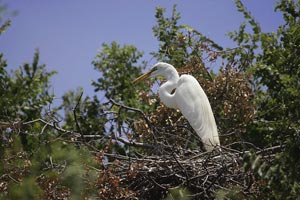
Copyright © Andy Long
All stages of rookery life can be found at any rookery as seen by this adult with no visible young.
Equipment used: Canon 1D Mark II, 100-400mm lens, ISO 320, f/5.6, 1/2000 sec.+2/3 EV
Bird rookeries are among the favorite spots for photographers to visit—especially when the nests are filled with birds. Mention rookeries to almost any bird photographer and numerous spots in Florida will enter the conversation immediately: Venice, the Alligator Farm and Gatorland. However, many other good ones can be found across the country, some in spots that sound highly unlikely.
When you describe a rookery as lying near an interstate where emergency helicopters are often flying directly overhead, and you note that there is no water next to it, your listener may look skeptical. If you add that you’re talking about a particularly productive rookery—where, in 2008 alone, numerous counts discovered 4,000 nests—your listener may scratch his head in disbelief. The location—sits in a small patch of trees a couple acres or so in size on the University of Texas Southwestern Hospital complex in Dallas, Texas. What also makes this an odd spot for a productive rookery is the weather that sweeps through the Dallas area from the beginning of the season in March until the last birds leave in July and August. Raging storms and extreme heat are not conducive to a thriving rookery. Even so, countless great egrets, cattle egrets, snowy egrets, ibis, black-crowned night herons and tri-colored herons call the area home.
During my first visit to this spot, as I searched the ground around the trees, I found about a dozen or so eggs that had provided meals to raccoons, cats, and whatever other predator that had come by for a free bite to eat. Someone told me there had been some very high winds earlier that week, and lots of baby birds–as well as eggs and nests—had been sent tumbling to the ground. It’s bad enough that out of most nests, one hatchling is booted out by a sibling. In Dallas, the weather causes special problems.
Besides the winds, there’s the heat. Because there are more than enough 100-degree days in Dallas to bake both eggs and tiny hatchlings, there need to be 4,000 nests in order for a good number of birds to make it through their first month or so of life. Luckily, the adults can lay more eggs to have a successful breeding season in spite of large numbers of weather-related deaths.
In addition, while many of the birds that land on the ground do end life as dinner for a predator, some are given a second chance. A photographer who makes several visits a week to this productive spot told me he frequently sees people from a rescue and rehab center walking the perimeter of the wooded area, searching out young ones to help. However, I found one victim that wasn’t going to be one of the lucky ones. The crew had already made a visit to the area earlier that day. The young great egret showed evidence that it had been a victim of a more dominant sibling that forced it from its nest. One side of its head revealed a hairless red patch, a sign of its having been pecked repeatedly. I turned to the other side of its head, so I could create a very nice portrait.
“The Good, the Bad and the Ugly”…
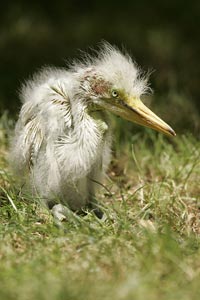
Copyright © Andy Long
The area behind its eye shows this young great egret was the victim of a nest rivalry and kicked out.
Equipment used: Canon 1D Mark II, 100-400mm lens, ISO 320, f/7.1, 1/1000 sec, +2/3 EV
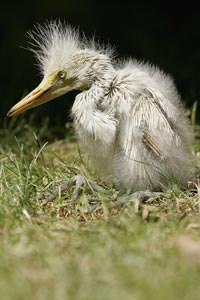
Copyright © Andy Long
Though not a perfect specimen, the photo opportunity of this booted out young egret offered a rare photo op.
Equipment used: Canon 1D Mark II, 100-400mm lens, ISO 320, f/7.1, 1/1000 sec, +2/3 EV
Even in death, animals provide opportunities for photography. It might seem like a bad thing to do, but the death of many of the young is part of the full story of a bird rookery as well as of life in the animal kingdom. At any given time of year, a photographer can capture moments from all the stages of life. During my early June visit, birds brought in material to build a nest, eggs that had been blown out of the nest just a few days earlier lay on the ground, recent hatchlings huddled together, and some young birds peeked out of the nests, ready to leave for good.
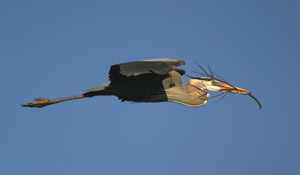
Copyright © Andy Long
With multiple people looking on, an incoming bird with nest material can be spotted and nice shots taken.
Euipment used: Canon 1D Mark II, 400mm lens, 1.4 teleconverter, ISO 100, f/4, 1/1500 sec
Every rookery has its own uniqueness. You need to check out each area before you decide how to approach your photography. At some, the choices are very straightforward. The Venice Rookery in Florida is one of the easiest to work. You drive up, get out of the car, walk over to the water’s edge, find a spot, set up, and start shooting. Boardwalk rookeries like the Alligator Farm in St. Augustine and Gatorland in Orlando let you walk back and forth to find the most productive location before you set up and shoot. It’s easy to be lured into staying in one spot to catch lots of images of one nest, but there is so much more, that you spend a bit of time and then move on to another productive spot.
The rookery at the hospital complex in Dallas is one that needs to be scouted all the way around before you determine where to set up. While shots can be taken at numerous spots around the perimeter, one or two offer the best activity. The time of day you shoot also plays a part in which is the best spot, because the direction of the light is important. The best afternoon/evening spot is not good in the morning since the area is backlit. Spots with light in the morning can be productive later in the day, but using a flash or bumping up the ISO is helpful in getting the best shots.
For example, this afternoon, several photographers gathered in one place to try to capture shots of the adult egrets flying to their nests–with a nice blue sky as a background. A couple people made little treks to another spot from time to time to see what was going on with a couple of young cattle egrets that had moved off the nest and were sometimes perching on a branch. My initial walk around the area revealed a young great egret out of the nest on a branch just a few feet above the ground. The light and background were not great, but the bird moved into position for several nice shots. Although I felt sad, realizing what my subject’s fate was going to be, I spent a bit of time on the young one that had been kicked out of the nest. It’s not too often the opportunity arises where you have a very young egret on the ground just a few feet in front of you for good, tight portrait shots.
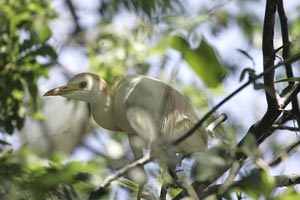
Copyright © Andy Long
Taking cover from the direct sun, a young cattle egret is large enough to move around but not quite ready to leave home for good.
Equipment used: Canon 1D Mark II, 100-400mm lens, ISO 320, f/7.1, 1/250 sec, +2/3 EV
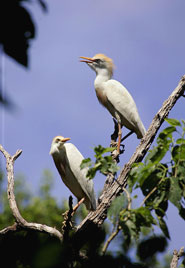
Copyright © Andy Long
A pair of sibling cattle egrets keeps an eye out for one of their parents to return with a meal.
Equipment used: Canon 1D Mark II, 100-400mm lens, ISO 320, f/7.1, 1/1250 sec, +2/3 EV
While nest activity is a big draw at rookeries, flight shots of the adults coming in with either nest material or food for their young provide another good subject. If numerous photographers work together, their several eyes can be looking in different directions, watching for an adult approaching, and they can announce its appearance. Having other photographers around is not a bad thing, as someone might tell you where a productive nest is in the area. On the other hand, the last time I went to the Venice Rookery several years ago, if I didn’t arrive early enough, there wasn’t room to for me to set up my tripod along the water’s edge.
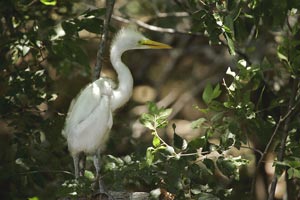
Copyright © Andy Long
This young great egret has left the nest and found a nice perching position somewhat low to the ground.
Equipment used: Canon 1D Mark II, 100-400mm lens, ISO 320, f/5.6, 1/125 sec
High Island outside of Houston, Texas, is a rookery I’ve had my eyes on for a couple of years. It will be a featured location on my 2010 Florida Birds Workshop. A mangrove island that has a great variety and numbers of birds, High Island has always been just a little too far away to shoot from land. However, a place nearby now rents small boats that my groups will use to reach the island. Our mobility will permit us to be the only ones present at that given time, an advantage we can’t enjoy at other rookeries where we are always competing with other photographers. No matter which rookery you like to visit, it’s sure to provide an exciting array of opportunities.
by Andy Long

Leave a Reply